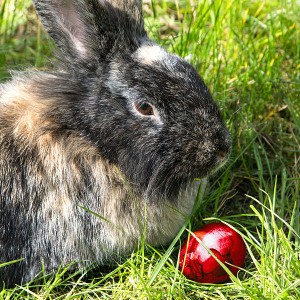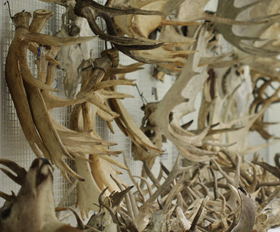The Easter bunny’s origins are linked with climate change
 The Easter Bunny apparently originated in German Lutherans’ traditions before 1682 when it was first mentioned in von Franckenau’s De ovis paschalibus.
The Easter Bunny apparently originated in German Lutherans’ traditions before 1682 when it was first mentioned in von Franckenau’s De ovis paschalibus.
In France and Belgium however, it’s not a rabbit that hides eggs in the garden for Easter morning but flying bells coming back from Rome (they went there for their holidays since the Maundy Thursday). For many people this makes no sense at all (flying bells, come on!) but on the other hand I think that a bunny carrying coloured eggs and hiding them does not make much more sense…
However, the Easter bunny makes a bit more sense than the bells after re-reading Ge et al.’s excellent paper, on the evolution of rabbits, hares and pikas (careful: cuteness overload!).
Lagomorphs originated in the early Eocene in Asia (that’s around 55-50 Mya – million years ago), they then split during the mid-late Eocene (~40 Mya) into the two families we know today, the Orchotonidae (the pikas and 31 other genera) and the Leporidae (hares and rabbits, 45 genera). As you might have noticed from my former posts, I’m vaguely (vaguely, vaguely, vaguely) interested in integrating fossils and living species within phylogenies, well Ge et al’s paper is a really good example of why one should not ignore past diversity. If you only look at living Orchotonids, you would miss the 31 other genera (97% of the family’s generic diversity!). Furthermore, if you only look at the body mass variation in living species of Leporids you would miss the rabbit T.rex: Nuralagus rex.
So now let us go back to our question and see when did the Easter bunny really originate and what are the origins of its family’s diversity. During the late Eocene/early Oligocene (~35-31 Mya), the climate was warmer, wetter and had higher CO2 levels than nowadays. This climate corresponded with a landscape dominated by forest and an increased distribution of C3 “grasses” notably Asteraceae, Rosaceae and Fabaceae which happens to be the principal diet of Orchotonids leading to an increased diversification in this group. However, Leporids, which appeared roughly during the same period, remained less diversified than their cute cousins.
The climate became gradually colder and drier during the Oligocene and Miocene period to reach a global cold and dry climate during the late Miocene (~5-10 Mya) slightly after “Nature’s Green Revolution” leading to the expansion of C4 “grasses” namely the poaceae (the true grasses). During this period, the number of Ochotonid genera “dramatically decreased” (to quote the authors) however Leporids expanded in both geographic range and generic diversity.
According to the authors, it was this “Nature’s Green Revolution” and the rise of the C4 plants that drove the shift in dominance between the two families of Lagomorphs, allowing the Leporids, that could digest C4 plants successfully and therefore benefit more from the increasingly open landscapes to radiate during the Pliocene (~5 Mya). Hopping may look ridiculous but it is actually a really efficient way to move around in open grasslands. This pattern of adaptation to global cooling and the rise of C4 plants is also found in the evolution of the Bovidae and Equidae.
So Ge et al.’s study gives us an explanation for why it is an Easter bunny that hides the eggs in C4 grass and not an Easter pika (hiding it in C3 grass). However, it is important to stress that these findings don’t in any way detract from flying bells or why we colour eggs…
Photo credit: wikimedia commons
